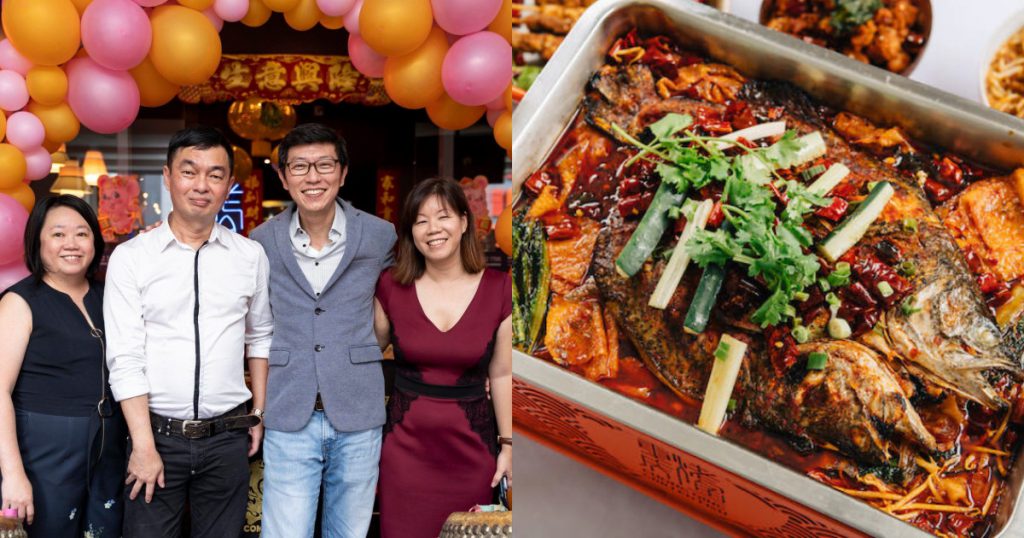By now, you can find mala grilled fish at literally almost any coffee shop in Singapore.
You might also recall watching mouthwatering grilled fish advertisements playing on SMRT trains.
Contrary to popular belief, Tan Yu, the erstwhile owner of these advertisements, is not the first to start the grilled fish fad in Singapore.
That title goes to Chong Qing Grilled Fish (CQGF).
Ditching Finance For F&B
Singapore’s first grilled fish restaurant was the brainchild of four friends who originally worked in the financial services industry: Khoo Siow Kiat, Lee Hwai Chi, Lee Ann and Lee Chor Whye.
Foodies and ardent lovers of Chinese culture, a pivotal trip to Chong Qing, China in 2008 convinced them to set up their own grilled fish restaurant in Singapore.
During the vacation, Siow Kiat and Hwai Chi decided to stop by Chong Qing. The municipality is only a two-hour flight from Beijing, and used to be Sichuan’s second-largest city.
Chong Qing grilled fish was a must-try. The dish has over two thousand years of history, says Siow Kiat, and was served in imperial courts and eaten by fishermen in ancient China.
The duo fell in love with the dish and have not looked back since.

“My first experience with authentic Chong Qing Grilled Fish was unforgettable,” he said.
“The first experience left my lips swollen from the heat. It’s a speciality concept, set in a casual dining environment, which makes the experience fun and unique.”
Upon returning to Singapore, the two convinced the remaining members of the group to set up a grilled fish restaurant together. They readily agreed, and CQGF’s first outlet was set up two years later on Mosque Street in 2010.
Turning A “Too Oily” Mala Dish Into A S’porean Staple
Mala grilled fish didn’t catch on in Singapore immediately. In fact, initial reception to the dish was overwhelmingly negative.
“Singaporeans absolutely hated it,” Siow Kiat admits. “They cited it being too heavy tasting, too oily, too salty, with all the negative perceptions of authentic Sichuan cuisine.”
It was a major letdown. The founders of CQFG had given their absolute best to recreate authentic Chong Qing grilled fish, even returning to Sichuan in 2009 to attend a culinary school.
When the culinary school refused to divulge the secrets of the Chong Qing grilled fish spice mix, Hwai Chi even reverse-engineered the spice mixes, Siow Kiat divulges.
On top of the poor reception to the dish, the ex-finance professionals had to grapple with their lack of F&B experience.
“We learnt it the hard way,” says Siow Kiat. “We knew absolutely nothing about setting an F&B up, though we are foodies. Till today, we’re still honing our skills.”

But their dedication paid off. Through trial and error, CQGF’s grilled fish recipe improved, eventually capturing the hearts of Chinese expats.
“(It happened) through word of mouth,” says Siow Kiat. “CQGF reminded the Chinese of their home, and there were very limited options (for authentic Chinese cuisine) in Singapore at that time.”
How Mala Crossed The Sea, And Landed In Singapore
You don’t need statistics to prove that mala cuisine has basically conquered Singapore’s F&B scene.
Despite Covid-19, Singaporeans are still feverishly consuming bowls of mala at hawker centres islandwide. When a dish becomes a staple food of the masses, that’s when you know you’ve made it.
Mala flavours have been adapted for potato chips, fish skin snacks, and even ice cream. Grilled fish, one of the key dishes fronting the mala trend, are now being sold in restaurants across Singapore.
LadyIronChef, HungryGoWhere and other major food blogs offer listicles of the the top grilled fish restaurants in Singapore.
CQGF, which tops these lists, is the OG of OGs — they are Singapore’s very first grilled fish restaurant, Siow Kiat assures me.
The CQGF founder attributes their F&B’s success to a combination of word of mouth and marketing. The present-day popularity of Sichuan cuisine is part of a natural transition for F&B, he observes.
“As China internationalises, more Asians travelling to the country get exposed to Chinese cuisine,” Siow Kiat explains.
“(At that time) there was a revival of the grilled fish concept ongoing in China. Many F&B groups set up their chains in major Chinese cities.”

Naturally, entrepreneurs who experienced Chinese cuisine overseas noted that there was a lack of options for Sichuan cuisine back home, Siow Kiat continues.
So expats and locals set up restaurants in Singapore offering the new cuisine. It also helps that Singapore’s barriers to entry for F&B are low.
Cuisine For The Culture
Despite being at the forefront of Singapore’s mala craze, CQGF doesn’t purport to be the best grilled fish restaurant, nor would they brand themselves as a grilled fish restaurant.
The reason for CQGF’s existence is to act as a medium for sharing Chinese culture with all, says Siow Kiat.
“Our brand statement is “Celebration of Culture”. A cuisine (arises from a culture’s) geography, terrain, people, races and religion.”
“It would be a waste if future generations forget about the beauty of what lies beneath the making of a particular dish.”
CQGF has expanded throughout Southeast Asia, with three outlets in Singapore, two in Malaysia and one in Myanmar.
The Burmese love Sichuan hotpot whereas Malaysians are relatively new to the concept, but SEA largely remains an untapped market, Siow Kiat notes.
Featured Image Credit: HungryGoWhere / Ahmad Iskandar Photography










